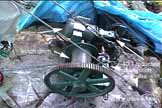
A side view of the winch components.
(Click on the image to see a larger version of this picture, and then use your browser's back button to return to this page.)
The Need for a Winch
Before Stephen and Marja bought the lot they had looked around the
Island to see how others managed to get the building materials up the 80 feet! One of his neighbours, Stefan, used a
hoist, and so much time was spent discussing its pros and cons. This lead to
Stephen building his own winch from scratch, with the help of Stefan. He
obtained a 40:1 reduction gear for an electric motor, and bought the half
horsepower electric motor. The gears, and the flexible coupling link were also
purchased. The winch drum and its base were constructed by Stephen and Stefan
using a welding machine.
Before describing the winch further, the following two photos should help
explain what it all looks like.

A side view of the winch components.
(Click on the image to see a larger version of this picture, and
then use your browser's back button to return to this page.)
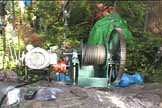
The winch assembly from in front of the winch. The winch drum must hold all the cable necessary.

The winch assembly from the motor side of the winch. The 40:1 reduction gear is behind the motor.
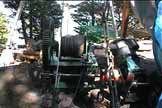
The winch assembly from behind the winch.
The electric motor and the reduction gear are mounted on one plate, the winch assembly on another. Holes were drilled in the rock and threaded rods were epoxied into place. The two parts were then attached to these as low down as possible, but because of the uneven rock surface, it was very tricky to get them aligned exactly. The flexible coupling allows a small margin of error in the alignment.
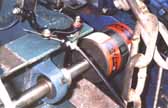
Flexible coupling used between the motor assembly and the winch assembly.
Initially a smaller flexible coupling was used, but after a winch failure this was changed to the much heavier version seen here. When there is little or no load to be sent down to the bottom, the drive shaft can be slid sideways to disengage the flexible coupling. After disengaging the coupling, the system "freewheels" the hook back down to the bottom. Sometimes a hand is necessary to slow the cable as it leaves the drum, but no mechanical external braking is necessary. (Initially a bicycle brake was added to provide mechanical braking, but this was not required and the brake was removed.)
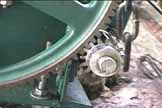
The final drive for the winch. The small gear has 15 teeth, the larger 108.
Without this winch arrangement the building project would hardly be possible. The winch provides the power for the hoist. The very thought of carrying 30,000 lbs (13,600 kg) of concrete and perhaps 60,000 lbs (27,200 kg) of lumber etc. up 80 feet (24 m) boggles the mind of all but the strongest of people! The only practical alternative is to use a helicopter, but this requires tremendous planning and good weather. Although the former may be a possibility, in Vancouver the weather cannot be guaranteed. Helicopter time is booked and paid for regardless of when the helicopter actually flies.
Go to page giving information on the hoist.
Return to Passage Island Site Development History Page. or to Passage Island Lot #9 Home Page. or to Site Index Page.